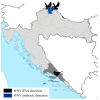Emerging Trends in the West Nile Virus Epidemiology in Croatia in the 'One Health' Context, 2011-2020
- PMID: 34449731
- PMCID: PMC8396195
- DOI: 10.3390/tropicalmed6030140
Emerging Trends in the West Nile Virus Epidemiology in Croatia in the 'One Health' Context, 2011-2020
Abstract
West Nile virus (WNV) is one of the most widely distributed (re-)emerging arboviruses. In Croatia, acute WNV infections as well as seropositivity were detected in humans, horses, birds and poultry. Although serologic evidence of WNV human infections dates back to the 1970s, no clinical cases were reported until 2012. WNV outbreaks, as well as sporadic infections, were continuously recorded in continental Croatian counties from 2012 to 2018. In addition, acute asymptomatic infections (IgM antibodies) in horses have been regularly notified in continental regions since 2012, while seropositive horses (seroprevalence rates 3.7-21.4%) were detected in both continental and coastal regions. Moreover, WNV seropositivity in poultry (1.8-22.9%) was reported from 2013 to 2020. During the largest WNV outbreak in 2018, WNV RNA was detected for the first time in two dead goshawks (Accipiter gentilis) from the same aviary in North-West Croatia, while WNV antibodies were found in one buzzard (Butteo butteo) from the same region. In addition, WNV RNA was detected in a dead blackbird (Turdus merula) at the Croatian littoral. The phylogenetic analysis of 11 strains detected in urine samples of patients with neuroinvasive disease and 1 strain detected in a goshawk showed circulation of WNV lineage 2. Thus far, WNV has not been detected in mosquitoes in Croatia.
Keywords: Croatia; West Nile virus; epidemiology; ‘One Health’.
Conflict of interest statement
The authors declare no conflict of interest.
Figures







References
-
- Sambri V., Capobianchi M., Charrel R., Fyodorova M., Gaibani P., Gould E., Niedrig M., Papa A., Pierro A., Rossini G., et al. West Nile Virus in Europe: Emergence, Epidemiology, Diagnosis, Treatment, and Prevention. Clin. Microbiol. Infect. 2013;19:699–704. doi: 10.1111/1469-0691.12211. - DOI - PubMed
-
- Platonov A.E., Shipulin G.A., Shipulina O.Y., Tyutyunnik E.N., Frolochkina T.I., Lanciotti R.S., Yazyshina S., Platonova O.V., Obukhov I.L., Zhukov A.N., et al. Outbreak of West Nile Virus Infection, Volgograd Region, Russia, 1999. Emerg. Infect. Dis. 2001;7:128–132. doi: 10.3201/eid0701.010118. - DOI - PMC - PubMed
-
- Vilibic-Cavlek T., Savic V., Petrovic T., Toplak I., Barbic L., Petric D., Tabain I., Hrnjakovic-Cvjetkovic I., Bogdanic M., Klobucar A., et al. Emerging Trends in the Epidemiology of West Nile and Usutu Virus Infections in Southern Europe. Front. Vet. Sci. 2019;6:437. doi: 10.3389/fvets.2019.00437. - DOI - PMC - PubMed
Publication types
Grants and funding
LinkOut - more resources
Full Text Sources

